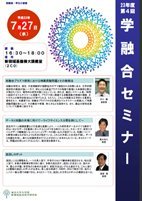AY2011 4th Gakuyugo Seminar
- Date&Time:
- Jul 27, 2011 16:30~18:00
- Venue:
- Large Lecture Room (2C0), New Frontier Science Bldg.

Singular perturbation problem in fusion plasma research and its new solution method
Associate Professor Masaru Furukawa
Fusion research is currently in the stage of construction of a large experimental reactor under international cooperation. On the other hand, the physics and mathematics of high-temperature plasmas, which form the core of the fusion reactor, remain unresolved and are the subject of scientific research. The physics and mathematics of high-temperature plasmas, which are the core of the core, remain to be elucidated. For example, the physics of multiscale phenomena due to a wide range of scale lengths and times, and wave phenomena related to plasma flow, and their mathematical description. Of course, these phenomena have important engineering implications as well. In this talk, we will discuss the singular perturbation problem as a classical multiscale phenomenon in fusion plasmas, and explain its concept, background, and ideas. Recent research results will also be briefly introduced.

Toward Data and Knowledge Sharing: An Example from the Life Science Field
Professor Toshihisa Takagi
With the rapid progress of massively parallel genome sequencers and other devices, we are now in an age where a single researcher can easily obtain more data than he or she can analyze in a lifetime. On the other hand, the research style has become more data-driven, which has led to the enclosure of data. A similar situation is occurring with knowledge, although the circumstances are different. There is a need to break through these contradictory situations, to share data and knowledge, and to discover new knowledge. In this seminar, we will clarify the problems and seek solutions.

Dish spinning robot
Professor Hiroshi Hosaka
There are two types of plate spinning. One is the amateur type, in which a rigid stick is swung with a twist of the wrist. The other is the performer type, in which a number of flexible sticks are swung intermittently to spin a number of plates. Three conditions are necessary for plate spinning to be successful: the level of the plates, the immobility of the center of gravity, and stability, all of which are satisfied by the method described above. Following this method, two types of dish spinning robots can be made. The amateur model is simple, costs 500 yen, and can be made in 30 minutes, and can be experienced at the Kashiwa Campus Open House. In this seminar, I will give an overview of the mechanics of dish spinning and the robot.
*The contents of this page were developed based on a machine translation.

